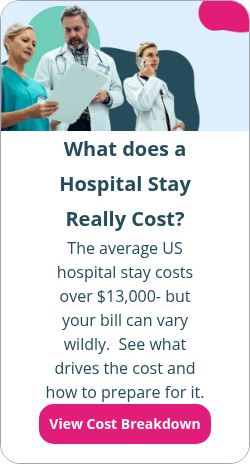What is the No Surprises Act?
By Elizabeth Walker on June 27, 2025 at 10:00 AM
U.S. medical debt is now $220 billion, with $88 billion appearing on consumer credit reports1. One major reason for the recent increase in healthcare debt is surprise medical bills.
When an individual gets medical care from an out-of-network provider, they may receive a surprise bill. A Commonwealth Fund study found that nearly half of those surveyed got a surprise bill in the past year for a healthcare service they thought their insurance covered2. To reduce the chances of this happening, Congress passed the No Surprises Act in 2020.
This blog explains everything you need to know about the federal No Surprises Act and how it makes the cost of healthcare more predictable for millions of U.S. consumers.
In this blog post, you’ll learn:
- How the No Surprises Act protects patients from unexpected medical bills, especially for out-of-network care and ancillary services.
- Key components of the law including balance billing protections and Good Faith Estimates.
- How employers can support employees with rising healthcare costs with a health reimbursement arrangement (HRA).
What is the No Surprises Act?
The No Surprises Act created billing standards and federal protections from surprise medical billing for consumers covered by group and individual health plans under certain circumstances. The federal government passed the No Surprises Act in December 2020 as part of the Consolidated Appropriations Act of 2021, and the law took effect in 2022.
The specific circumstances covered under the No Surprises Act include:
- Emergency services that an out-of-network provider performs
- Out-of-network provider care received at an in-network facility
- Additional healthcare services
The Act mandates that patients seeking care for these circumstances are only liable for care at in-network cost-sharing amounts. This means that certain non-emergency out-of-network ancillary services can’t bill patients more than their in-network cost-sharing amount. This is the case even if they received notice or consented to the service.
The Act applies to medical services and items like:
- Anesthesiology
- Pathology
- Radiology
- Neonatology
- Lab services
- Emergency medicine
- Other diagnostic services
Other key features of the Act include requiring healthcare providers and insurers to negotiate reimbursements without involving the patient. There are also provisions for processing independent dispute resolutions through “baseball arbitration.”
Baseball arbitration is when a provider and a health insurance company present an arbitrator with the amount they believe the plan should pay the provider. The arbitrator then selects one proposal or the other. The decision made during arbitration is binding and isn’t subject to review by a court.
Who does the No Surprises Act affect?
The No Surprises Act requires health plans to charge surprise out-of-network services at the patient’s in-network rate. To this end, the Act affects employers who sponsor health plans, third-party administrators (TPAs), insurance brokers, and other healthcare providers.
This includes, but isn’t limited to:
- Hospitals
- Hospital outpatient departments
- Ambulatory surgical centers
- Payers
- Providers
- Facilities
- Ancillary providers performing emergency medical care and non-emergency services, like air ambulance transportation services
Why is the No Surprises Act important?
About 74% of Americans with private health insurance worry about whether they can afford an unexpected medical bill3. Luckily, the No Surprises Act created stricter patient protections and reporting standards, which are crucial for regulating healthcare costs.
New procedures for the No Surprises Act include:
- Reporting requirements for air ambulance service providers.
- Disclosures and reporting requirements about compensation to agents and brokers.
- Procedures for enforcing the No Surprises Act provisions against providers, healthcare facilities, and air ambulance providers.
- Disclosure and reporting provider requirements for health insurance carriers.
- Revisions to existing enforcement procedures.
Before the No Surprises Act, around a fifth of emergency claims and a sixth of in-network hospital stays included an out-of-network medical bill4. A patient’s health insurance plan may have covered a part of a surprise medical bill. But the individual would have to pay the remaining balance. This meant patients needing unexpected medical care, with few in-network options, frequently went into debt when paying the balance.
The No Surprises Act increases transparency in the healthcare system in three ways:
- Insurers and providers must maintain up-to-date provider directory information.
- Insurers must disclose in-network and out-of-network cost-sharing amounts, such as deductibles and out-of-pocket maximums, to plan participants.
- Health insurance carriers and network providers must provide patients with cost estimates before they receive medical care.
These new regulations on transparency and pricing improve the patient experience and send fewer provider bills to debt collectors.
What you should know about the No Surprises Act
The main aspects of the No Surprises Act are surprise balance billing, the Good Faith Estimate, and gag clauses. These three rules lay the foundation for protecting consumers from surprise medical bills.
Let’s review each of these No Surprises rules in the sections below.
Surprise balance billing
The term "out-of-network" describes a provider or facility outside your health plan. An out-of-network provider can bill a patient for the difference between what their health insurance plan agreed to pay and the total amount charged for a service. This is called a “balance bill”, which has gone through a process called balance billing.
Under the No Surprises Act, consumers have federal protections against balance billing from emergency care providers and specific services at in-network hospitals, ambulatory surgical centers, and other medical centers.
A health plan typically must:
- Cover emergency services by out-of-network providers without prior authorization.
- Only charge individuals for the copays, coinsurance, and deductibles they would pay if the provider or facility were in-network. They must also show the amount in the plan’s Explanation of Benefits (EOB).
- Count any amount an individual pays for emergency or out-of-network services toward the balance of their health plan’s deductible, coinsurance, and out-of-pocket maximum.
Good Faith Estimate
Healthcare providers must also give an uninsured patient an estimated bill for medical items and services. This is called a Good Faith Estimate.
Consumers have the right to a Good Faith Estimate for the total expected dollar amount of any non-emergency services or medicine.
This includes related expenses such as:
- Medical tests
- Prescription drugs
- Medical equipment
- Telemedicine services
- Hospital fees
Individuals can ask their provider for an estimate before scheduling their appointment. But even if they don’t, their provider should give them a written estimate no later than one business day before they receive their service or healthcare item.
It’s critical to save a copy of the Good Faith Estimate. Thanks to the No Surprises Act, patients can dispute the bill if their balance is $400 more than the estimate they received.
Gag clauses
Lastly, the No Surprises Act prohibits gag clauses5. Gag clauses prevent health plans and insurers from entering into contracts with healthcare providers, networks, TPAs, or other service providers that would restrict the plan from accessing or sharing certain information.
Under a gag clause, contracts can’t restrict the following information:
- Disclosing health costs or quality of care details to network providers, plan sponsors, or plan participants.
- Electronically accessing de-identified data for individual participants and enrollees upon request.
- Sharing the above information with respect to federal regulations, such as HIPAA.
The No Surprises Act requires insurers that provide fully insured and self-insured health plans to submit a gag clause attestation on December 31 each year on the Centers for Medicare & Medicaid Services (CMS) website6 For those offering one of these group health plans, the Department of Health & Human Services, Labor, and Treasury websites have instructions on how to fill out the form properly7.
The following health benefits don’t require an attestation:
- Plans that only provide excepted health benefits
- Health reimbursement arrangements (HRAs)
- Short-term health insurance
- Limited-duration health benefits
How an HRA can help employers cover their employees’ healthcare costs
Even with the No Surprises Act, costly medical expenses may still be an issue for some individuals. Employers should review the type of health benefits they offer to ensure it does enough to combat rising healthcare costs.
If you’re an employer looking to do more to support your employees’ medical care, an HRA may be your best bet.
An HRA is an IRS-approved personalized health benefit that allows employers to reimburse employees tax-free for qualified out-of-pocket medical expenses. Depending on the type of HRA, health insurance premiums may also be eligible costs.
Employers give employees a set monthly allowance that they can use to buy healthcare services and items. Once employees submit proof that they bought an eligible expense, their employer reimburses them tax-free up to their allowance amount.
Unused HRA funds stay with the employer at the plan year's end or if an employee leaves their company. This makes them a good option for businesses that want greater control over their budget and taxes.
Here are three HRAs that employers can design and manage with PeopleKeep by Remodel Health:
- The qualified small employer HRA (QSEHRA) is for employers with fewer than 50 full-time equivalent employees (FTEs). It has annual maximum limits, but no minimum limits. Employees must have a health plan with MEC to participate in the benefit.
- The individual coverage HRA (ICHRA) has no minimum or maximum contribution limits and can work for employers of all sizes. Business owners can vary allowances and eligibility using employee classes. Participating employees must have an ACA-qualified individual health plan to use the benefit. Applicable large employers (ALEs) can also use an ICHRA to satisfy the employer mandate.
- The group coverage HRA (GCHRA) is for employers of any size that offer a group health plan. Employees enrolled in their employer’s group health plan can use their GCHRA to pay for out-of-pocket expenses that the group plan doesn’t fully cover. Like the ICHRA, it has no contribution limits and has employee class customization options.
Using a flexible and customizable HRA, employees can better protect themselves from surprise bills and better control their out-of-pocket costs, regardless of whether they go to an in-network or out-of-network facility.
Conclusion
The healthcare system is always under the watchful eye of the federal government and the Department of Health and Human Services. So, it’s not surprising that several new regulations have appeared in recent years. The No Surprises Act is complex. But creating billing standards for health insurance companies improves the rights and protections of millions of Americans.
Even with surprising billing under control, employers should double-check their health benefits package to ensure their employees have enough financial support. An HRA is a great way to cover more out-of-pocket medical costs for your staff and their families. Book a call with an HRA specialist to learn more about how this customized health benefit can work for you.
This article was originally published on April 13, 2022. It was last updated on June 27, 2025.
1. The burden of medical debt in the U.S.
2. Unforeseen health care bills and coverage denials by health insurers in the U.S.
3. Americans' challenges with health care costs
4. An examination of surprise medical bills and proposals to protect consumers from them
5. The No Surprises Act: “Gag clauses”
6. Gag clause prohibition compliance attestation submission
7. Gag clause prohibition compliance attestation instructions
Check out more resources
See these related articles

Does an HRA work with Medicaid?
Find out if an HRA can be used with Medicaid. Learn how HRA reimbursements work for employees enrolled in Medicaid and what limitations may apply.

What employers need to know about HRA debit cards
Are you considering HRA debit cards for your workers? Find out why they may not be the best option for your company and what alternatives you can explore.

How to calculate FTEs to determine ALE status
Learn what a full-time equivalent employee (FTE) is, what your FTE number means if you’re an ALE, and how to calculate how many FTEs you employ.



